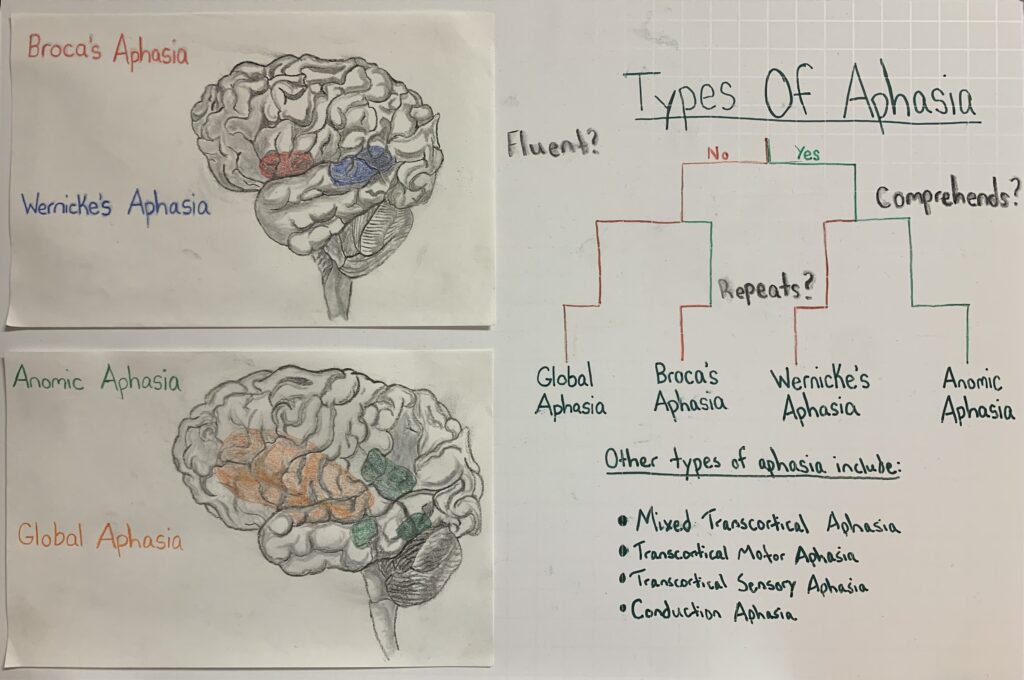
When determining type of aphasia in a patient, professionals use three categories to narrow results. First being fluency: can the patient speak fluidly with the correct tone? Can they write fluidly? Second is comprehension: can they understand what others are saying, as well as themselves? Can they understand written language? Last is repeating: can the patient repeat certain phrases or words given to them? With a CAT scan, cognitive tests, nerve function tests, and the information above, medical professionals can correctly diagnose patients.
When people are diagnosed with global aphasia, they have trouble being fluent, comprehending and repeating language. Global aphasia is the most severe form of aphasia, as it disrupts a majority of the brain’s left hemisphere, indicated by the name. It may be so severe that people might be mute, or only able to mumble sounds or single words. This type of aphasia is usually common with other injuries including paralysis and blindness. Broca’s aphasia is different in that it has the same symptoms, yet the person can fully comprehend the conversion happening. Also called “Expressive Aphasia,” this is the most common form of aphasia. They often have trouble repeating words back to others and can tell when they can’t. Broca’s aphasia is named after Paul Broca who first identified the region of the brain being affected by aphasia. This region is located in the inferior frontal gyrus. Wernicke’s aphasia is also named after neurologist Carl Wernicke, who discovered a second region of the cerebral cortex that affects speech. This region is found in the superior temporal gyrus. Wernicke’s aphasia is defined as the inability to comprehend and repeat, but can fluently speak. This means that speech is usually confusing and off topic. People commonly develop anosognosia with Wernicke’s aphasia, a condition in which the person does not understand that they have an illness or medical problem. For those unclear, anosognosia is often associated with bipolar disorder or schizophrenia. Lastly, anomic aphasia is the least severe of them all, in which the person can fully comprehend, repeat words, and are fluent in speaking and writing. The issue is they struggle to find words to express their meaning, using multiple words to describe the word they cannot remember. This type of aphasia usually affects a variety of locations in the left hemisphere, but can also cause damage in the right hemisphere, although rare.
For treatment, early stages of depression or other mental health disorders should be recognized before trying to solve aphasia. Especially in those who comprehend their inability to speak, depression can occur. So, treatment decisions should be based on the type of aphasia and noted with how well they are coping. Based on the professional journal Aphasia: Current Concepts in Theory and Practice, by various authors, studies have shown that the best way to treat Broca’s aphasia is therapy “directed at translating sound to motor speech productions to produce simple sentences.” In addition, the best way to treat Wernicke’s aphasia is therapy “directed at processing speech for comprehension or meaning in sentences.” Other treatments can include neuroplasticity or “repetitive transcranial magnetic stimulation” which have been proven to help with nonfluent aphasia. Otherwise, the best form of treatment is starting early-on with loved ones helping in speech and writing. This approach is often called “person-centered” aphasia treatment. Setting rehabilitation goals and making sure the patient understands that their speech can be recoverable, is vital in a patient’s desire for treatment. Understand that people with aphasia can feel hidden from the world, it is best to be patient in listening so they can soon feel unprecedented confidence in speaking.

I really liked the drawings specifically the colors. I like the grey of the pencil and then then the color coded areas of the brain that you were addressing. The flow chart was super understandable and easy to follow. This made it simple to understand and explain to your audience the different types of aphasia and the signs and symptoms associated with them. I think having the signs and symptoms of the other types of aphasia would be beneficial but I can see how it would probably require different flow charts. Overall I would say you did a great job at explain the different types of aphasia and the parts of the brain that are correlated with it. I really enjoyed your drawings which help provide a strong visual aid of the areas where the aphasia stems from.